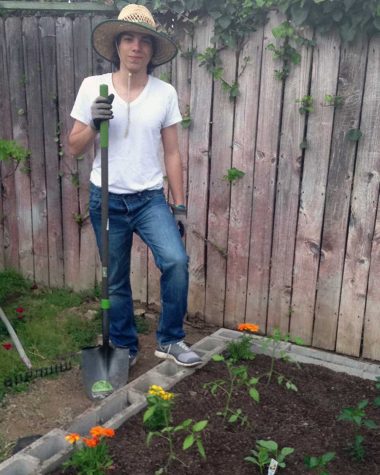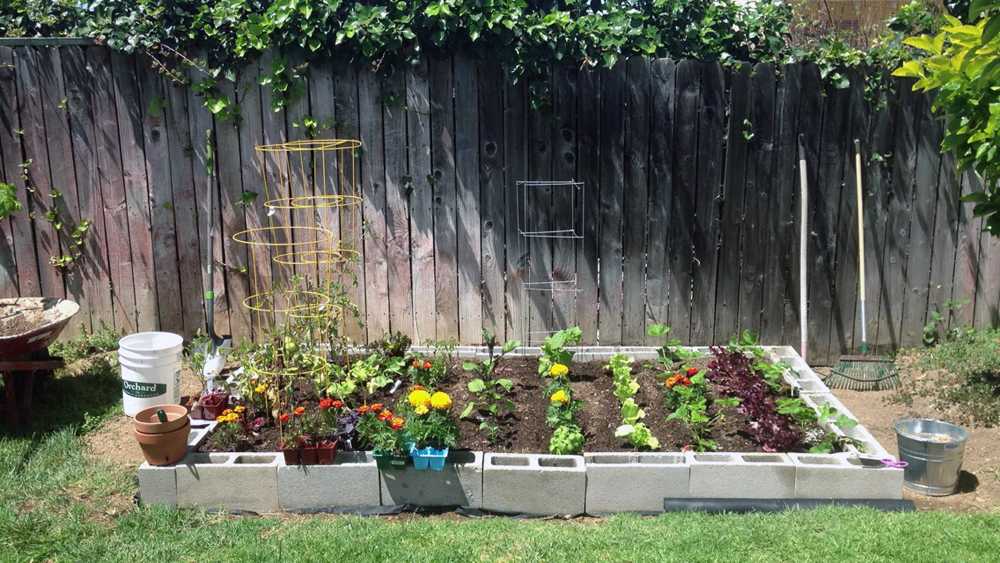Painting an Edible Landscape
May 12, 2014
Having grown up in the multifamily housing complexes that dominate Glendale’s residential landscape, community life played an important part in my everyday tasks: I would play soccer with the neighborhood children; my grandpa would play backgammon with friends from two apartments down the block; the neighbors would join us for monthly evening parties.

Food, too, served as the foundation for many social interactions: every morning, my grandmother would go on a 10-minute walk to the nearby Jon’s Marketplace, returning with fresh produce and, for the neighbors, the newest sale information; my working mother would rush to Trader Joe’s just after work, buying veggies and other ingredients for us and for the elderly couple next door.
Yet in the entire daily hubbub, no one stopped to ask just where the food we put into our bodies came from. Grandma had a pot of mint growing in the shady balcony, but what about everything else? Why grow it when you could just buy it from Jon’s, in impressive quantities?
“Home-grown is better,” says my grandmother Mary Koulian, a Glendale resident for over 15 years. “As a child in Syria, I remember my mother had a beautiful vegetable garden for our family of five in the backyard. But when we moved to Soviet Armenia and later to Glendale, there were few, if any, resources for gardening.”
Mrs. Koulian expressed her disappointment with not being able to grow food for her own. “Yes [gardening] is back-breaking work, but knowing where your food comes from gives you a sense of security that I wish I still had.”
It was only a decade ago when my family moved into a single-family home, well equipped with a front lawn and backyard that could nourish greens of all sorts for our multi-faceted diets. My grandma was quick to rush to the scene, planting a variety of herbs and fruit trees, including lemon, orange and apple. Soon to follow were blackberry, grapes and peppers. However, with her assistance needed in raising my newborn cousin, she moved to my uncle’s home and was forced to abandon her noble, one-year attempt at urban agriculture.
Forward the scene years later to my teenage self and me finding a way to help out around the house. Having grown food-conscious thanks to Food Inc. and the many other documentaries that exposed the food industry, I knew I should revive and extend the edible paradise that could exist just yards away from where my family eats dinner.
In fact, individuals and communities feeding themselves is gaining popularity, as agriculture is no longer restricted to the countryside. The capability to grow fresh fruits and vegetables is slowly adapting to city life, be it in backyards, balconies or even rooftop greenhouses.
If you don’t believe me, the U.S. Department of Agriculture says that “around 15 percent of the world’s food is now grown in urban areas.” That means more people are eating local, fresher food and supporting local economies. That means less resources are spent on packaging, storing, and transporting food for miles that could simply be grown yards, if not feet away without any of the extra chemicals invested in keeping food fit for eating (take for instance the humble lettuce, which on average has 51 pesticides sprayed on it, more than any other vegetable crop, according to the Pesticide Action Network).
And while for some families growing their own food means combating rising food prices due to economic or environmental problems such as California’s drought, to me growing food would mean not just serving our voracious Middle-Eastern palates that crave spicy peppers and zesty squashes, but also creating a sustainable ecosystem that could also give back to the native plants and animals that call our backyard home — or, for seasonal visitors, hotel.
What I planned to undertake was a self-sufficient and sustainable method of agriculture not uncommon to the growing trend of urban farming nationwide, called permaculture gardening.
Permaculture, a blend of the words “permanent” and “agriculture,” is an intellectual product of Australians Bill Mollison and David Holmgren. Created in 1976, it features a range of ideas and tenets borrowed from many different centuries of agricultural and social experimentation packed into one unifying system. Some of these principles include companion planting, mulching and composting, which all serve to learn from nature in creating sustainable human habitats.
Co-founder of permaculture, David Holmgren, defines his creation in this way: “Consciously designed landscapes which mimic the patterns and relationships found in nature, while yielding an abundance of food, fibre and energy for provision of local needs.” And more than 40 years later, Warren Brush, a permaculture teacher in the USA has calculated that there are 2.5 million practitioners of permaculture in 135 countries, reportedly feeding more people than all of the world’s aids programs combined.
With these fascinating discoveries in mind, I sought to convert our backyard rookie garden into a rich and plentiful permaculture design garden. Starting from literature in books and magazines, to video tutorials on YouTube, I learned many methods of permaculture that should have taken years to gain from experience. Moreover, I discovered that Clark’s very own librarian Susan Newcomer is certified in Permaculture, something she had learned many years ago as a college student.
“I was always so fascinated with growing foods and when I found out about this class on permaculture, I immediately signed up,” Newcomer said. “I was privileged to become certified in something so unique and have lived by its tenets ever since.”

Indeed, there is something different about permaculture that seems to be earning it the spotlight it has. So starting this year, I decided to move from the drawing boards to the great outdoors.
The first step to any garden is the same in real-estate as well: location, location, location. Full to partial sun is ideal for vegetable crops, and we Southern Californians have nothing to complain about there. Searching for the perfect spot, I stumbled upon an open patch of dirt in the corner of our backyard that received sunlight for about two-thirds of the day and enjoyed afternoon shade thanks to a garden border fence.
Next came building a raised bed, which is a large container that is filled with rich soil for planting crops. To create the rectangular bed 9 ft. long by 5 ft. wide and 1 ft. tall, I considered using wooden planks, however was reluctant to do so because the wood would attract termites — not the best of neighbors when your wooden home is a few feet away. So instead, I utilized about 25 cinder blocks from Home Depot for only 80 cents a piece, a better investment that would be friendly to the environment and last for a longer time than wood.
After proper soil fixation, plants should be planted, by seed or pre-grown, in accordance to plant companion principles; the fact of the matter is that some plants will perform better when near other beneficial plants. And so, I planted marigolds alongside tomatoes, and lettuces next to strawberries with the knowledge that they are said to be companion plants that help ward off plant diseases. Other flowering plants could be used to invite beneficial insects such as bees that are pollinators, as well as ladybugs, which fend off pests such as aphids and ants.
Another principle is composting, which involves recycling weeds and other green “waste” into rich soil by storing them in containers so they decompose. I bought a simple trash bin from the Home Depot and started filling it with fresh clippings from the garden. Slowly but surely, the organic matter will accumulate and transform into soil for the garden. A variety of daily waste can be composted, such as kitchen green waste, newspapers, and even shredded printer papers. Thus, an environment for self-sufficiency takes root.
Water is another big issue, especially with the recent drought. While harvesting rainwater is a great and easy fix (as well as a money-saver), it is not necessarily practical thanks to California’s long and dry summers. Instead, clay, porous pots called ollas can be placed into the soil next to the roots of plants, which can then be filled to provide water directly to the roots instead of overhead irrigation, which can lead to evaporation and water loss.
Finally, mulching is a perfect example of mimicking nature in the garden. As with forests, the soil is never left bare to the elements; there is always a layer of decaying leaves, hay, or other organic material that protects the soil from the sun, wind and water, as well as keeps the soil moist. Therefore, simply covering the garden bed with a layer of bark clippings, hay or foliage can greatly enhance the overall performance of the entire garden, improving both the quality of the soil and the ability of plants to absorb nutrients.
In the end, applying permaculture tenets to urban gardening can be a great idea for long-term gardeners. As each year progresses, less and less work will be needed to maintain the various plants that serve both the ecosystem and the dinner table. Perhaps as food prices soar and more people realize the benefits of growing your own food, there will be greater knowledge of gardening available to a greater number of people. As for my grandmother, Mrs. Koulyan, she can only observe in awe as the edible landscape she had envisioned years ago finally comes to life. “I am very excited for this summer, more for the food than the beach weather.”
